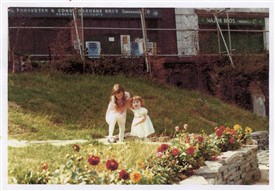Jenny Healey
A community worth fighting for
An interview conducted by Jennifer Grote

Jenny's children in the Japanese Garden, 1975
Jenny Healey
Jenny Healey was two years old when she moved to Covent Garden and still has vivid memories of the old market. She remembers waking up early to go to the flower market with her father when she was young. ‘It was full of life’ she says smiling. However, when the market moved to Nine Elms in 1974, things really changed for the community. She remarks that ‘it was a very sad time for everyone’, as there suddenly was a derelict and quiet market space where the hustle and bustle used to be. Still, Jenny does not dwell on sad memories and instead moves on to the much happier subject of the Covent Garden community: ‘And here we are today, still fighting’, she says.
When the market moved, Jenny started going to meetings and handing out leaflets whenever she could. She was by then a young mother and her main concern was to save the living space for the generations to come, for ‘our children’, and ‘to keep the community going’. Family is very important to Jenny; she has five children of her own, who also ‘wouldn’t want to live anywhere else’. This determination to stay where her family has always lived, and to ensure her children and grandchildren could also stay, is what sparked her enthusiasm. She says ‘the campaign had a good feel about it. We got excited, and a bit rough, now and then’. Meetings were like open forums to express opinions and some form of voting usually followed the talks. The general attitude amongst people was positive and they believed that the campaign was going to be successful. When asked about any doubts or possible feelings of defeat she remarks that some residents might have felt like giving up but that she never did. ‘In for a penny, in for a pound’ is her motto when it comes to the community’s fight for Covent Garden.
This positive outlook is maintained throughout our conversation. When I ask about the spaces lost due to redevelopment, and ask whether Jenny feels like something vital was destroyed, she reflects that ‘things will never stand still’. For her it is all ‘part of the parcel’ and things could have been worse. What she does miss are the people that are now gone, either because they moved or because they were very old. So it is not so much ‘the place one misses but the people one used to know’. She feels that redevelopment in itself isn’t so bad, ‘as long as you keep a tight rein on it’.
Still, looking back at the times spent in the Japanese Garden, one of the green spaces lost due to construction, she cannot help but feel slightly nostalgic. When she talks about the tea parties they used to have, and how the children would meet up after school and bathe in the little pond, her face lights up. Jenny mentions musicians, entertainment, and some little stalls; but mostly, ‘the locals would sit and talk’, giving the whole affair an atmosphere of ‘a family day out’. The pictures she shows me are of her kids, mainly taken in the Japanese garden and on the little bridge that was right at its centre. When I ask where the family went once the garden was gone, Jenny smilingly replies, ‘Oh, we’ve got so many parks’, and mentions the swing gardens at Drury Lane. She adds that by that time the community club, too, had already started up.
At this point in our conversation Jenny thanks the Community Association and conclusively states what I have been sensing all along: ‘We wouldn’t live anywhere else. We’re happy where we are’. The brief exchange we had that day somehow underlines how tight-knit the community here really is. To me, as a bystander, it does feel a lot like family.
This interview was conducted as part of the Lottery Heritage Fund project, ‘Gentlemen We’ve Had Enough: The Story of the Battle to Save Covent Garden’. On Friday 10th May 2013, King’s College London students, supported by Westminster Archives, the Covent Garden Community Association, and the Centre for Life-Writing Research at King’s College London, interviewed Covent Garden residents about their memories of the area. Students’ accounts of their interviews have been added to this Covent Garden Memories website. For more information see: www.kcl.ac.uk/artshums/ahri/centres/lifewriting/gentlemen.aspx.